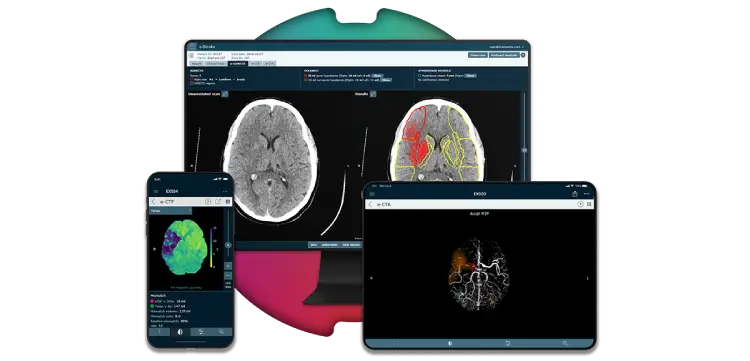
New treatments have emerged in the past few years that offer stroke patients a chance of a better outcome, and an Oxford-based company is hoping its artificial intelligence (AI) software can expand access to this life-saving procedure.
When a patient with suspected stroke is first admitted to A&E, they will usually undergo a series of brain scans to help the attending physician confirm the stroke and understand its severity.

Stroke is a time-critical disease, with each minute representing a loss of two million neurons. Fast and accurate interpretation of the brain scans leading to diagnosis and treatment is essential – but all too often a trained specialist is not readily available, leading to treatment delays.
“Currently, every 30 minutes, a stroke patient who could have been saved, dies or remains permanently disabled, not because of stroke but because they’re admitted to a hospital that doesn’t have the expertise to currently diagnose and select the patient for life-saving treatment,” explains Michalis Papadakis, co-founder and CEO of Brainomix. A spin-out from the University of Oxford, the company has developed AI-powered software called e-Stroke, which can help doctors interpret brain scans and make more confident treatment decisions.
One particular treatment for stroke patients, mechanical thrombectomy, has emerged as a real game-changer in stroke care, enabling more patients to recover from stroke with minimal disability. This treatment is complementary to clot-busting medication, known as thrombolysis. Data shows that for every three patients treated with mechanical thrombectomy, one will avoid serious disability.”
The procedure is performed by a trained specialist, who inserts a device through an artery in the patient’s groin to access the area of the brain where the clot causing the stroke has been lodged, ultimately removing it to allow blood flow to return to the obstructed region.
It is estimated that at least 10 per cent of stroke patients in the UK would be eligible for thrombectomy, and yet only about 2 per cent are actually treated – a gap that Brainomix is hopeful it can help close with the adoption of its AI software across stroke networks.
In hospitals where e-Stroke has been installed, all brain scans from suspected stroke patients are automatically processed and run through the AI software, generating results within one or two minutes that help the physician to more accurately and confidently interpret the images – a critical first step in the treatment pathway, particularly for thrombectomy patients, who may then also require a transfer to a larger hospital where thrombectomy can be performed by the specialist.
Brainomix’s e-Stroke Mobile App enables clinicians across the network to share images, facilitating faster decisions for treatment and transfer.
In September 2020, Brainomix was selected for a prestigious NHSX AI award that will enable the company to deploy its software across five UK stroke networks as a way to assess its “real-world” impact on patient care. Matthew Gould, the chief executive of NHSX, predicts that e-Stroke could help to prevent serious disabilities for thousands of stroke patients.
One network already benefiting from the incorporation of e-Stroke into its stroke pathway is Devon and Cornwall – a rural region with a dispersed network of smaller hospitals that may transfer certain patients over long distances to Plymouth for thrombectomy.
Martin James, consultant stroke physician at Royal Devon & Exeter Hospital, has confirmed that the deployment of e-Stroke across the region is a crucial component in a plan to increase the number of patients receiving thrombectomy, and has already observed the software helping to speed up the time it takes to assess a patient’s eligibility for the life-saving procedure with faster image interpretation and sharing of images with the e-Stroke Mobile App.
“We can already see the tangible benefits in reducing referral and door-in-door-out times with e-Stroke, which is helping to maximise each patient’s chance of a good outcome from earlier reperfusion,” he says.
Brainomix recently announced a partnership with Stryker, one of the leading providers of devices used to treat stroke patients. Through the partnership, the two companies are aiming to enable broader utilisation of e-Stroke to help more patients gain access to thrombectomy, and by extension, be given a chance for a faster and long-lasting recovery.
Jeff Wyrtzen is chief marketing and business development officer at Brainomix.






